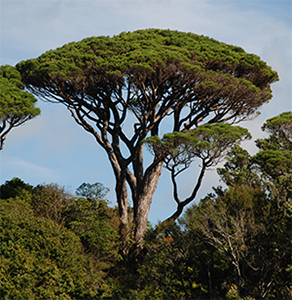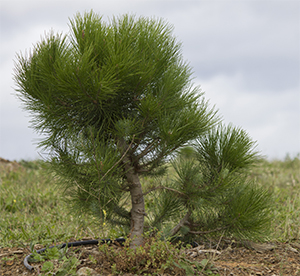Pinus pinea

Other common names
Umbrella pine; Italian: Pino domestic; Spanish: Pino piñonero; French: Pin pignon.
Origin of the species name
Pinus is classical Latin for pine; pinea is a Latin adjective meaning of pine.
Family
Pinaceae
Date planted
December 2009
Lifespan
Trees of this species live around 300 years.

General description
This is a medium sized evergreen tree with an umbrella shaped canopy and a short and stocky trunk. The bark is red-brown and deeply fissured. The foliage of young trees has a bluish hue for up to ten years before maturing to green. The cones are ovoid shaped and broad and are slow to mature. Height 15m Spread 15m.
Natural distribution and habitat
The species is thought to be native to the coastal areas of Mediterranean Europe and the Near East, although many of the present day stands are possibly the result of plantings going back to Roman times. It is a coastal tree growing on the lower mountain slopes and hills down onto the dunes and flats. Growing above scrub or in low forests, it is fire tolerant.
Conservation status
Although it is not classified as a threatened species, the increasing salinisation of land and increased summer forest fires are becoming the most severe problems threatening the Mediterranean forests in which it occurs.
Planting pattern
Planted in a regular square grid pattern.
Uses
The edible nuts have been harvested since prehistoric times and millions of kilograms are now harvested every year. They are used in recipes ranging from pastries to salads. The tree resin is also used for medical treatments, varnishing and waterproofing. Even the needles have been used to make green dye. The timber is of poor quality.
Further reading
Farjon, A (2010) A Handbook of the World's Conifers. Brill.
